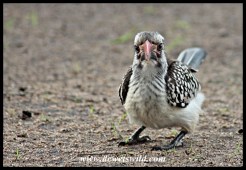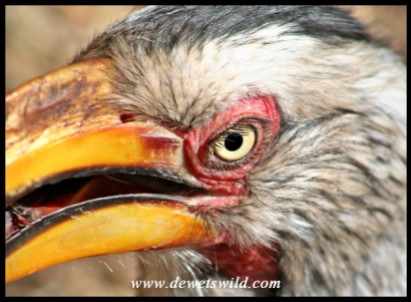Last week’s photo post “Treat“, featuring a family of hornbills raiding a picnic table, raised so much interest in the species that we decided to dedicate another special post to our country’s hornbills.
We’ve already introduced you to the biggest and most conspicuous of the family, the Southern Ground Hornbill (Bucorvus leadbeateri). These fascinating birds are an endangered species. Have a look at our special post about the Southern Ground Hornbill to learn more.

Southern Ground Hornbill
South Africa is also home to five other species of hornbills, all much smaller than the ground hornbill and all diurnal in their habits. They share a most intriguing method of nesting and raising their chicks. Just before laying, normally in the summer rainy season, the mostly monogamous pair selects a hole in a tree (rarely in cliffs) to serve as a nest, often using the same hole for this purpose year after year. Both sexes then proceed to seal the female inside the hole, plastering up the entrance with mud, food remains and droppings, leaving only a small slit through which the male can pass food to the female and chicks. While inside the hole, the female moults and regrows her tail and flight feathers. She lies a clutch of two to seven eggs and incubates them for between 24 and 30 days (varies between the species). When the chicks are around 40 to 50 days old, the female breaks out and then helps to reseal the hole. The chicks then stay inside and are fed by both parents for another two weeks or so before breaking out and taking their first flight. The chicks stay with their parents for around eight weeks after leaving the nest and are fully grown by one year of age.
African Grey Hornbill
Lophoceros nasutus
Length: 45 – 51cm
These hornbills can be found in acacia savannas (thornveld), mopaneveld, dry broadleaved woodlands and riverine woodlands, ranging from extreme northern Kwazulu-Natal through Mpumalanga, Limpopo, Gauteng and North West Province to the Northern Cape. They include a wide variety of food in their diet, taking insects, beetles, spiders, frogs, chameleons, small rodents, chicks and eggs and some fruits, searching for food mainly in the branches of trees.
Grey Hornbills normally move around in pairs or small flocks, but may gather in larger flocks of over 100 birds in the dry winter, when they become more nomadic.
The African Grey Hornbill has a wide distribution across Africa and its population appears to be stable, with the IUCN classifying their conservation status as “Least Concern”.
Crowned Hornbill
Lophoceros alboterminatus
Length: 50 – 54cm
The Crowned Hornbill is widespread in the Eastern Cape, Kwazulu-Natal and the lowveld of Mpumalanga and Limpopo Provinces, where it inhabits inland, coastal, mountain and riverine forests. They feed on insects, small rodents and reptiles, seeds and fruit and are mainly arboreal.
They can usually be found in pairs or in small flocks of up to seven birds.
Though the IUCN considers the Crowned Hornbill’s conservation status as “Least Concern”, it is thought that their numbers are dwindling due to loss of habitat.
Southern Red-Billed Hornbill
Tockus erythrorhynchus rufirostris
Length: 40 – 47cm
Red-billed Hornbills occupy open bushveld, thornveld, mopaneveld, thickets along streambeds and semi-arid woodland, where they prefer to search for food on the ground in open, heavily grazed areas. They have a varied diet that includes dung beetle larvae which they find in the dung of elephants and other large mammals, other insects, scorpions, the eggs and chicks of small birds, small reptiles and seeds and berries.
They move around in groups of up to twelve birds and love taking dustbaths.
Southern Yellow-Billed Hornbill
Tockus leucomelas
Males are generally larger than females, with a bigger beak. Length: 48 – 60cm, weight: 132 – 242g.
The Yellow-billed Hornbill is found in a wide range of habitats, from semi-arid savannas, dry broadleaved woodland and thornveld to riverine woodland, ranging from Kwazulu-Natal through Mpumalanga, Limpopo, Gauteng and North West Province to the arid Northern Cape. They have an omnivorous diet that includes insects, scorpions, snakes, rodents, eggs and chicks of small birds, berries, fruits, nuts and seeds. They feed mainly on the ground and will use its bill to turn over debris like small rocks and logs and dig in elephant dung in search of food.
Despite being widespread and common, the loss of suitable large nesting trees is causing their numbers to decline outside conservation areas. The IUCN considers the conservation status of the Yellow-billed Hornbill as “Least Concern”.
Trumpeter Hornbill
Bycanistes bucinator
Length: 58 – 65cm, Weight: 450g – 1kg
Trumpeter Hornbills inhabit evergreen lowland, coastal and riverine forests in the Eastern Cape, Kwazulu-Natal and the lowveld of Mpumalanga and Limpopo Provinces, and subsists on a diet of fruit, particularly from the sycomore fig (Ficus sycomorus) and bushwillows, and large insects.
These birds are normally seen in small groups of about five, sometimes aggregating in flocks of up to 50, some records even mentioning 200! Their call sounds very much like a baby’s crying.
Due to an apparently stable population, wide distribution and no substantial threats to their numbers, the IUCN classifies the Trumpeter Hornbill as “Least Concern”.













































































